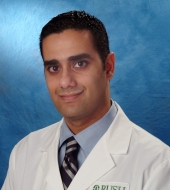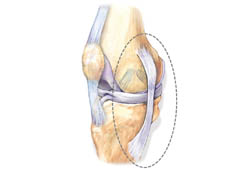Summary
Definition
History and exam
Key diagnostic factors
- injury due to excessive or repetitive valgus loading of MCL
- medial knee pain
- joint effusion
- tenderness
- laxity on valgus stress testing
Other diagnostic factors
- ecchymosis
- audible pop or tearing sensation at time of injury
- difficulty walking
- instability symptoms of knee
- mechanical knee symptoms
- knee deformity
- positive anterior drawer test
- positive posterior drawer test
- positive Lachman test
- positive pivot shift test
- joint line tenderness
- chronic pain
Risk factors
- participation in activities involving valgus stress at the knee joint
- age 20 to 35 years
- age 55 to 70 years
- weak muscles that cross the medial aspect of knee
Diagnostic tests
1st tests to order
- plain x-rays of knee
- stress x-rays of knee
Tests to consider
- MRI of knee
Emerging tests
- diagnostic ultrasound
Treatment algorithm
isolated grade I injury
isolated grade II injury
isolated grade III injury
MCL + anterior cruciate ligament (ACL) combined injury
MCL + nonanterior cruciate ligament (ACL) combined injury
persistent high-grade valgus laxity after ≥3 months
Contributors
Authors
Sanjeev Bhatia, MD

Director, Hip & Knee Joint Preservation Center
Northwestern Medicine Central DuPage Hospital
Northwestern University Feinberg School of Medicine
Warrenville
IL
Disclosures
SB receives publication royalties from the following Nova publication: Ligamentous Injuries of the Knee. SB has stock ownership in: AI Digital Ventures, LLC; Edge Surgical; TDA Ventures, LLC; and Joint Preservation Innovations, LLC. SB is on the Board of Directors for AI Digital Ventures, LLC and Joint Preservation Innovations, LLC. He also holds patents pertaining to bone resection related technology. He has received other financial or material support from Smith & Nephew and Graymont Medical, LLC, and has been a paid speaker for the latter. SB also is a board or committee member for the American Academy of Orthopaedic Surgeons and the Arthroscopy Association of North America.
Nikhil N. Verma, MD

Professor
Department of Orthopedic Surgery
Section of Sports Medicine
Rush University Medical Center
Chicago
IL
Disclosures
NNV declares the following competing interests: American Orthopaedic Society for Sports Medicine: board or committee member; American Shoulder and Elbow Surgeons: board or committee member; Arthrex, Inc: research support; Arthroscopy: editorial or governing board; publishing royalties, financial or material support; Arthroscopy Association Learning Center Committee: board or committee member; Arthrosurface: research support; Cymedica: stock or stock options; DJ Orthopaedics: research support; Journal of Knee Surgery: editorial or governing board; Minivasive: paid consultant, stock or stock options; Omeros: stock or stock options; Orthospace: paid consultant; Ossur: research support; SLACK Incorporated: editorial or governing board; Smith & Nephew: IP royalties, paid consultant; Smith & Nephew, Athletico, ConMed Linvatec, Miomed, Mitek: research support; Vindico Medical-Orthopedics Hyperguide: publishing royalties, financial or material support.
Peer reviewers
Jason M. Scopp, MD
Director
Joint Preservation Center at Peninsula Orthopedic Associates
Salisbury
MD
Disclosures
JMS declares that he has no competing interests.
Peer reviewer acknowledgements
BMJ Best Practice topics are updated on a rolling basis in line with developments in evidence and guidance. The peer reviewers listed here have reviewed the content at least once during the history of the topic.
Disclosures
Peer reviewer affiliations and disclosures pertain to the time of the review.
References
Key articles
O'Donoghue DH. An analysis of end results of surgical treatment of major injuries to the ligaments of the knee. J Bone Joint Surg. 1955 Jan;37-A(1):1-13. Abstract
American Medical Association, Committee on the Medical Aspects of Sports. Standard nomenclature of athletic injuries. Physical Therapy. 1969 Nov;49(11):1323.Full text
Fetto JF, Marshall JL. Medial collateral ligament injuries of the knee: a rationale for treatment. Clin Orthop Relat Res. 1978 May;(132):206-18. Abstract
Warren RF, Marshall JL. Injuries of the anterior cruciate and medial collateral ligaments of the knee. A long-term follow-up of 86 cases - part II. Clin Orthop Relat Res. 1978 Oct;(136):198-211. Abstract
Phisitkul P, James SL, Wolf BR, et al. MCL injuries of the knee: current concepts review. Iowa Orthop J. 2006 Feb;26:77-90.Full text Abstract
American College of Radiology. ACR appropriateness criteria: acute trauma to the knee. 2019 [internet publication].Full text
Wijdicks CA, Griffith CJ, Johansen S, et al. Injuries to the medial collateral ligament and associated medial structures of the knee. J Bone Joint Surg Am. 2010 May;92(5):1266-80. Abstract
Halinen J, Lindahl J, Hirvensalo E, et al. Operative and nonoperative treatments of medial collateral ligament rupture with early anterior cruciate ligament reconstruction: a prospective randomized study. Am J Sports Med. 2006 Jul;34(7):1134-40. Abstract
Marchant MH Jr, Tibor LM, Sekiya JK, et al. Management of medial-sided knee injuries, part 1: medial collateral ligament. Am J Sports Med. 2011 May;39(5):1102-13. Abstract
Giannotti BF, Rudy T, Graziano J. The non-surgical management of isolated medial collateral injuries of the knee. Sports Med Arthrosc. 2006 Jun;14(2):74-7. Abstract
Reference articles
A full list of sources referenced in this topic is available to users with access to all of BMJ Best Practice.

Differentials
- Medial meniscus tear
- Soft tissue contusion of the medial knee
- Tibial plateau fracture
More DifferentialsGuidelines
- The posteromedial corner of the knee: an international expert consensus statement on diagnosis, classification, treatment, and rehabilitation
- Treatment of combined injuries to the ACL and the MCL complex: a consensus statement of the Ligament Injury Committee of the German Knee Society (DKG)
More GuidelinesLog in or subscribe to access all of BMJ Best Practice
Use of this content is subject to our disclaimer